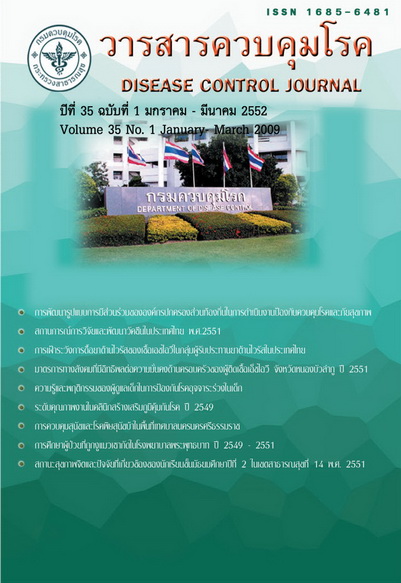Promotion for Injecting Drug User utilizing Voluntary Counselling Testing Services among Drug Users: A Study of Pattani Drug Dependence Treatment Center
Keywords:
HIV infection, AIDS, VCT, (Voluntary Counselling and Testing)Abstract
This qualitative research aimed to: 1) develop a model for early investigation in IDU group, and 2) find the evidence of HIV infection in drug users . The subjects were 49 drug users, and 22 nurses at the Pattani Drug Dependence Treatment Center. The results revealed that among 49 drug users, 9 were injecting drus users practicing needle sharing. Before starting the program, 22 nurses completed a pre-test knowledge about VCT(Voluntary Counselling and Testing), Harm Reduction and Patients' Right, and the average score of VCT was lowest to other categories ( 4.9 from 10, SD 0.78), and also the knowledge in harm reduction average was 5.1 (SD 1.1). The comparison of the knowledge between pre-test and post-test were significantly different (p<0.05). The nurses had to do VCT averaging 2 .3 times (SD 1.2) for each drug users, before they decided to do blood testing for HIV. The prevalence of HIV within the IDU group, we found that they were 100 % HIV positive, and other drug users were 100 % HIV negative. All The nurses thought that the VCT program should be built to the part of the routine screening and care for all drug users. Conclusion: To encourage the VCT among the drug user groups, a very important entry point because The entry point into Voluntary counselling and testing(VCT) is critical, and this program will increase the chances for the group to enter into the ARV (Antiretroviral drugs) program at the Drug Dependency Treatment Center. Early detection of HIV blood test would help either with the appropriate care or advice given to the IDU group.
Downloads
References
2. ธนรักษ์ ผลิพัฒน์. ผลการเฝ้าระวังการติดเชื้อเอ็ชไอวี ประเทศไทย ปี พ.ศ. 2547. [เข้าถึง 20 พ.ค. 2550 ]. สืบค้นจาก : htpp:// www.epi.moph go.th
3. สำนักงานโครงการพัฒนาแห่งสหประชาชาติ ประเทศไทยกับโรคเอดส์ความก้าวหน้าและสิ่งท้าทาย.2547. [เข้าถึง 20 พค.2550 ]. สืบค้นจาก : htpp://www.aidsthai.org
4. Sero- surveillance in IDUs in Pattani and Songkhla provinces during 1997 - 2006. [ เข้าถึง 20 พ.ค. 2550].สืบค้นจาก : htpp://www.aidsthai. org
5. สำนักงานสาธารณสุขจังหวัดปัตตานี.รายงานประจำปีของสำนักงานสาธารณสุขจังหวัดปัตตานี 2549. (อัดสำเนา)
6. นวลตา อาภาคัพภะกุล. แนวคิดในการลดอันตรายจากการใช้สารเสพติด. สงขลานครินทร์เวชสาร 2550 ;25: 61-64.
7. สำนักงานหลักประกันสุขภาพแห่งชาติ. คู่มือบริหารจัดการการดูแลผู้ติดเชื้อเอชไอวี/ผู้ป่วยเอดส์ ในระบบหลักประกันสุขภาพถ้วนหน้า. พิมพ์ครั้งที่ 1. รุ่งศิลป์การพิมพ์, 2550.
8. Department of Disease Control Ministry of Public Heang. (2006). Review on National Plan for the Prevention and Alleviation of Hiv/ Aids in Thailand 2002-2006: Drug Dependents. Ferng Fair pringting company limited. Bangkok .
9. Aceijas C,et al(2004). Global overview of injecting drug use and HIV infection among injecting drugs users : AIDS 2004;18 (2) 295-303.
10. UNAIDS.2006. Report on the global AIDS epidemic 2006. [ เข้าถึง 20 พ.ค 2550] สืบค้นจาก : htpp:// www.aidsthai.org
11. WHO,UNAIDS, UNODC. การเข้าถึงผู้ใช้ยาเพื่อลดอัตราการติดเชื้อเอชไอวี. World health Organization Department of HIV/AIDS Geneva Switzerland. 2005.
12. Hament FF and Down AM (2004) The chaging face of the HIV edidemic in western in westernEurope: what are the implications for public health polices Lancet 364 : 83-94.
13. EMCDDA (2004).European Monitoring Centre for Drugs and Drug Addiction. Annual report on theastate of the drugs uropean Union and Norway 2004 , EMCDDA , Lisbon, 2004. http://anualreport. Emcdda. en. int
14. Onlsen .Merle M. Group Counselling . New York.: Holl Rinehart and Winston. Inc.. 1970 : 31
15. WHO, UNAIDS, UNODC. การรักษาผู้ติดเชื้อเอชไอวีที่ใช้ยาชนิดฉีดเข้าเส้นด้วยยาต้านไวรัส. World health Organization Department of HIV/AIDS Geneva Switzerland. 2005.
16. Wodak et al. (2005). Effectiveness of sterile needle and syring programmes. Internation Journal of Drug Policy (Supplement ). Forthcoming.
Downloads
Published
How to Cite
Issue
Section
License
Articles published in the Disease Control Journal are considered as academic work, research or analysis of the personal opinion of the authors, not the opinion of the Thailand Department of Disease Control or editorial team. The authors must be responsible for their articles.






